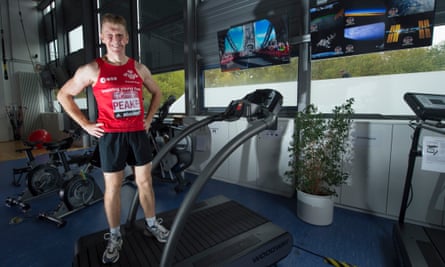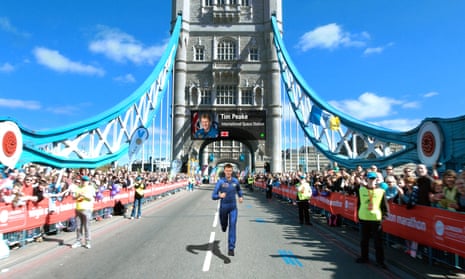What happens when you hit the wall in space? This is not a daft question from a
sci-fi novel, but a real possibility that the British astronaut Tim Peake might have to consider. Peake, who is due to blast off for the International Space Station on 15 December, is aiming to become the first man to run a marathon in space. At 10am on 24 April next year, he will line up alongside 37,000 other runners for the start of the most famous marathon in the world: London’s. He will just happen to be about 400km above them when he does it.
The Guardian’s product and service reviews are independent and are in no way influenced by any advertiser or commercial initiative. We will earn a commission from the retailer if you buy something through an affiliate link. Learn more.
Peake is no marathon novice – in 1999, back down on earth, he finished the London course in 3h 18min 50sec – and though he is not expecting to beat that time in space, he has been training hard already. “As soon as I got assigned to my mission, I thought: wouldn’t it be great to run onboard the ISS,” he says. “The London Marathon is a worldwide event. Let’s take it out of this world!”
Running 26.2 miles is tough for anybody, but the additional demands of doing it in microgravity creates unique difficulties. “One of the biggest challenges I’ll be facing is the harness system,” he explains. “It has a waistbelt and shoulder straps. That has to provide quite a bit of downforce to get my body on to the treadmill, so after about 40 minutes, that gets very uncomfortable. I don’t think I’ll be setting any personal bests. I’ve set myself a goal of anywhere between 3:30 to 4 hours.”
While this feat may represent rather a lot of small steps for mankind (after all, 42,195 metres make up a marathon), 26.2 miles of giant leaps have already been taken by a woman – back in 2007, Nasa astronaut Sunita Williams ran the Boston marathon on a treadmill up on the ISS. But what makes Peake’s attempt different is that he will be running virtually through the streets of London, while orbiting miles above them.

This is thanks to a very clever app called RunSocial. The company behind it film running courses – including the Prague and London marathon routes – and create “mixed reality” videos that runners can watch while on the treadmill. The video playback matches their speed, creating a very smooth and convincing effect of moving through the landscape. If the treadmill slows, the video slows, and vice versa. So, just like runners on the physical streets, Peake will be moving past the famous landmarks of the course – the Cutty Sark, Tower Bridge, and possibly hitting the wall on that last, will-sapping stretch along the Embankment.
“The thing I’m most looking forward to is that I can still interact with everybody down on Earth,” says Peake. And anyone who wants to join him can do so – everyone using RunSocial has an avatar that reflects their real place on the course, so fellow virtual runners on the day can overtake, be passed by or run alongside the astronaut for some pacemaking help. Peake’s own avatar will help identify him – he has been given his very own virtual European Space Agency flight suit.
The app itself is free and the download of the marathon route costs £4.99, but every single person who applied for a place in the marathon ballot – successfully or not – will be sent a link for a free download in January 2016. And come April, the words everyone will be hoping not to hear will be: “London ... we have a problem.”
